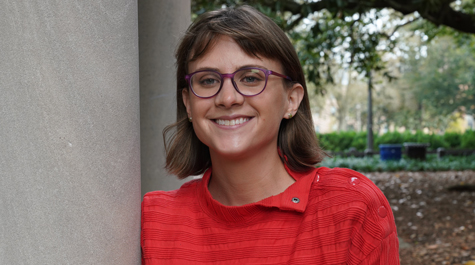An archaeologist returns to Djibouti to survey 13th- to 19th- century sites
Djibouti is a tiny country in the Horn of Africa; its deepwater port and strategic location have made it a hub of commerce for centuries.
Madeline Gunter Bassett notes that documents ranging from 1st-century Greek records to 14th- and 15th-century accounts by Arab and Chinese explorers illustrate the importance of Djibouti to merchants from India, Asia, Europe and the nearby Arabian Peninsula.
Bassett is a Ph.D. candidate in William & Mary’s Department of Anthropology. She will use funding from a National Science Foundation Doctoral Dissertation Improvement Grant to spend three months surveying and mapping archaeological sites in southeastern Djibouti.
She will be studying sites important to pastoralists in the 13th through 19th centuries, or the Medieval Islamic through Ottoman periods. Bassett says that pastoralists — nomadic goat and camel herders — historically represented one of the two main populations of Djibouti. Other residents lived a sedentary life in the towns along the coast.
“Pastoralists were, for the most part, only seasonal visitors to coastal towns. During the dry, winter months, they moved their herds back to the coast to settle around wells where their herds would have access to water,” Bassett said. “Archaeological and documentary evidence suggest that during these periods, pastoralists and more sedentary city dwellers gathered at beach markets outside coastal towns to trade with merchants arriving from the Arabian Peninsula.”
Pastoralists and local city dwellers came to these beach markets with local goods such as salt, ivory and aromatic resins. Visiting merchants brought exotic goods such as porcelains from China, glass beads and cloth. Merchants also brought new ideas, the most important of which was Islam.
Bassett’s project will be overseen by Martin Gallivan, professor and chair of the anthropology department, and Neil Norman, associate professor and director of graduate studies in the department. She says that her work will be the first systematic archaeological survey of 13th- to 19th-century sites in Djibouti, as well as the first archaeological study in the eastern Horn of Africa to reconstruct long-term patterns of interaction and land use by pastoralists.
This trip will be Bassett’s sixth trip to Djibouti. During her previous trips, she found artifacts that document the trading relationships of pastoral groups, including exotic ceramics and hundreds of modified cowrie shells. She is especially interested in the cowrie shells.
Over the course of two previous trips, Bassett excavated more than 1,200 modified cowrie shells and shell fragments, including more than 700 from a single 5-by-5-meter unit. She thinks that these dense concentrations of modified shells could be evidence of local bead production by pastoralists.
To test her hypothesis, she sent a sample of modified shells to a shell bead specialist at University College Dublin for further analysis. Bassett notes that cowrie shell beads are important for a number of reasons.
“During some periods, specific species of cowries were used as currency,” Bassett said. “During other periods and in other regions, cowries were generally valued as adornment items that could be stitched onto objects and clothing. In the eastern Horn of Africa, cowrie bead production may have been one way that pastoralist communities engaged with and acquired non-local objects at coastal markets.”
Bassett explains that mapping and excavating pastoralist sites is uniquely challenging. For one thing, the marginal, arid environments in which mobile herders typically live are bad for site preservation.
“Djibouti is a highly arid, desert landscape, so archaeological sites there are often subject to harsh natural processes,” she said.
In addition, there’s the fact that the pastoralists she studies were constantly moving, so the material traces they leave behind for archaeologists to find are more ephemeral than those left by sedentary societies.
“Nomadic herders occupy sites for a relatively short period of time, so they leave behind fewer structures, which are often altered during times of re-habitation,” Bassett said.
Bassett explained that she takes a landscape approach to the archaeology. It’s an approach that allows archaeologists to examine patterns of human activities and environmental resources across multiple spatial and temporal scales. She believes such an approach will help her to overcome these challenges in Djibouti.
“I’ve created an ArcGIS database that includes archaeological data from pedestrian surveys of the southeastern Djibouti coastline, as well as vegetation and water data from multispectral Landsat imagery,” she said. “This database will help me to identify how pastoralist activities — like animal herding — articulated with natural resource nodes — like wells and pasture zones.”















